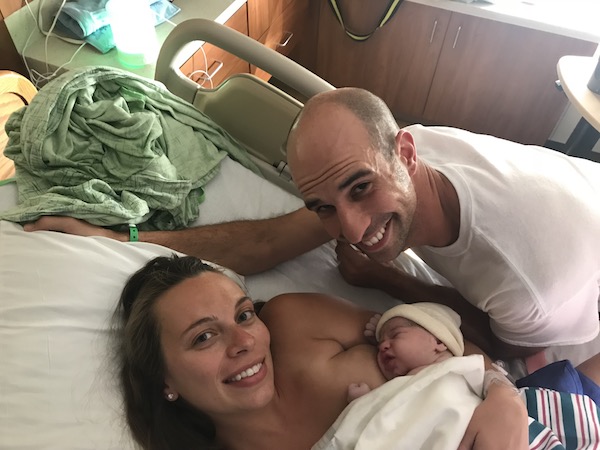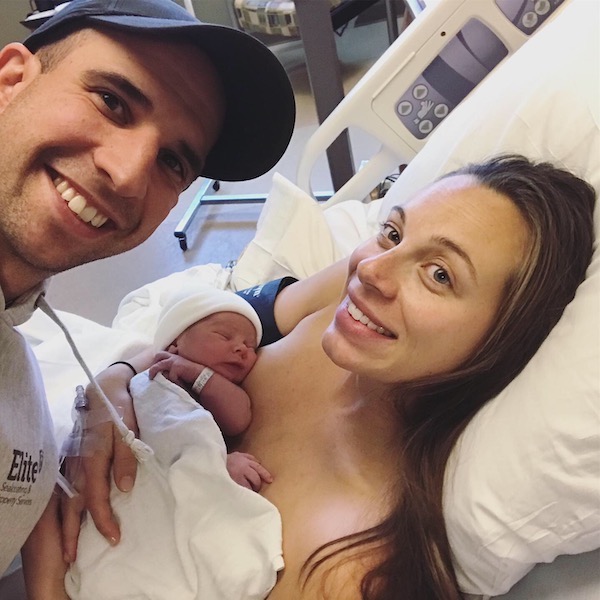

If you’re interested in learning about ways to prepare your body for natural birth, this post is for you. Actually, it’s for anyone who wants to take control of their birth experience and learn ways that may help it go smooth and quick! And who wouldn’t want that?!
If you want to dive deeper than preparing your body for natural birth, and get into other topics like choosing a hospital, preparing your mind, and tips for use while in labor at the hospital, I created an entire course on ALL the ways I know to prepare for natural birth. You can check that out here.
First and foremost, congratulations on your pregnancy! It’s such an exciting time. As I write this post, my babies are 3 years old, and 2, and man, does the time go fast! Take it all in.
I gave birth to both of my babies naturally (unmedicated) in a hospital, and I am so grateful for those experiences I had. If you told me years earlier that I would have natural births, I would not have believed you. The thought of one day going through childbirth terrified me most of my life, and I never had confidence about my ability to push a baby out! So, once I became pregnant, I became obsessed with researching and finding all the ways I could possibly prepare for an easier labor and birth. That led me to finding lot of interest in natural birth.
My goal going into labor was to have a birth “as natural as possible,” but I wasn’t opposed to getting an epidural if I felt I absolutely needed one. I did know for sure, though, that I wanted to wait for as long as possible before getting one to allow labor to progress on its own (it’s commonly understood that epidurals can interfere and slow down labor). Well, I waited and I waited, and about 7 hours after arriving at the hospital, as I was about to get in the shower for some pain relief, my water broke, and instantly I felt a super strong urge to push. I was fully dilated and baby girl was quickly on her way.


Her birth was the most incredible thing I had ever gone through, as I’m sure is the case with any new parent, whichever way baby comes. But just the shock, empowerment and confidence that I felt immediately upon her birth, plus the huge surge of feel-good endorphins… it’s really hard to explain what that feels like, but there is nothing else like it.
I remember the moment that my daughter was placed on my chest. I said, “Hi baby.” And “I did it? Oh my God, I did it!” I actually had to question for a second, like “wait, did that just happen?!” In an instant, I went from feeling exhausted with barely any sleep for 2 days and nights, to the most energized I had ever felt. I went from being fearful about childbirth my whole life, and doubtful in the months, days and hours earlier, to being the most confident I had ever been in my life. That experience changed me in all the best ways. [You can read her full birth story here]
I knew then, that if I were ever to have another baby, I would want to do it the same way. When my daughter was 6 months old, I became pregnant again. I ended up giving birth to my son, unmedicated in the same hospital. This time though, I had so much more confidence in my ability to have a natural birth. And although my labor with him was a bit longer, and as far as I can remember, more painful, I knew it was doable and I had the power to push through. [You can read Asher’s birth story here]


One thing I’ve come out of my birth experiences knowing is that natural, unmedicated birth is much more attainable than most people think. While interventions certainly have their place, I do believe they are widely overused. Birth does not have to be a scary thing like most pregnancy themed movies or shows portray it to be.
Here are some of the things I did to prepare my body for natural birth, and some of my top birth preparation recommendations.
Disclosure time: Please know that I am not a doctor. I am not a nurse, a midwife, or a doula, nor did I go to school for this. I’m just a mom who has had the personal experience of going through natural childbirth twice. I spent a lot of time throughout my first pregnancy researching and reading all the ways I could find to get through a natural childbirth. What I read and learned helped me immensely, and I’m just here to share this information with anyone else who may be interested. So, do not take any of the information in this article as medical advice. Talk to your healthcare provider before implementing any new health regimen, especially when it comes to pregnancy.
Preparing Your Body For Natural Birth
These are the things that you can physically do to help your prepare your body for labor and birth.
1. Feed your body nutritious foods
Get lots of healthy fats, fiber-rich foods, and protein. You cannot overestimated the importance of good nutrition in pregnancy. Eating right will help your body substantially throughout your pregnancy, labor, delivery, and recovery. Aside from fueling your body with what it needs to thrive and helping to maintain healthy weight gain, eating a healthy diet can also help reduce your risk of preeclampsia, which often leads to early induction or scheduled c-section. Not to mention, it is vital for your growing baby. Eating healthy for the growing baby in your belly is one of the greatest gifts you can give him or her.
Click here to view some of the best foods to eat while pregnant.
2. Drink more water
The uterus is a muscular organ, and just like with any muscle in the body, it functions best when properly hydrated. Throughout your pregnancy and especially as you approach and go into labor, drink lots and lots of water. If water is not your think, try infusing it with fruit for a little taste, or eat water-rich foods like watermelon, cucumbers, peaches, strawberries, and alike. I definitely recommend investing in a durable stainless steel water bottle* and bringing it with you filled with water wherever you go.
3. Walk
Some of the benefits of walking during pregnancy include reducing back pain, relieving constipation, preventing excess weight gain, promoting post pregnancy weight loss, and it improves endurance, which reduces the risk of c-section! As labor approaches, walking allows you to take advantage of gravity, which in combination with movement, can promote optimal positioning of baby.
4. Do prenatal yoga
Yoga, specifically prenatal yoga for pregnancy, is amazing for opening your hips, stretching and toning your muscles, improving flexibility, reducing pain, improving endurance, and also centering your mind and your breath.
Another awesome benefit (if you’re enrolling in a class), is that you get a chance to meet and chat with other pregnant moms and supportive instructors who may have some good insight.
5. Squat
Doing squats throughout pregnancy is one of the greatest ways to strengthen your pelvic floor muscles, which is beneficial for helping to push baby out more effectively. Squatting also helps open up your pelvis, and improves posture which can help a lot with lower back pain. Make sure you’re doing them correctly, otherwise doing them can have an adverse affect. Check out this video on correct pre-natal squatting position. I found this video helpful for showing proper squatting form for pregnancy.
Doing squats throughout your pregnancy will help greatly with building stamina. If you’re able to squat in labor, I say do it! I delivered my daughter using a squat bar attached to the hospital bed. The gravity and hip opening helps so much! I was not a fan of lying on my back.
6. Trade your desk chair for a yoga/birthing ball
Not only is this great for relieving pregnancy pain and discomfort, like tailbone pain, hip or back pain, but sitting on a birthing ball* also improves posture, helping baby with positioning. The earlier you start using one, the better.
Make sure you use an anti-burst ball*, so it’s safe enough to sit on! Also, make sure your hips are always higher than your knees. If your knees are higher than your hips when sitting on the ball, the ball is too small. Get a bigger one, or see if it can be inflated more. I definitely recommend getting a little hand pump for the ball, to always keep it inflated.
7. Visit the chiropractor
If you’re comfortable with it, and especially if your approaching or past week 30 of pregnancy and baby is not yet head-down, getting chiropractic adjustments may be very beneficial. Just make sure to do some research before seeing just any chiropractor. Make sure they are well experienced with seeing pregnant women, and are trained in the Webster Technique. This is very important. The Webster Technique is a specific chiropractic technique used on pregnant women, that focuses on the pelvis and sacrum, as well as muscles and ligaments in and around that area. The primary goal of the Webster Technique is to address and help correct misalignments in these areas. I like this video explanation on how the Webster Technique may benefit pregnant women.
I really believe that getting chiropractic adjustments later in my pregnancies helped me to have natural, unmedicated births, and maybe even saved me from needing a c-section. In both of my pregnancies, at my 32 week appointments, BOTH of my babies were in transverse positions. This means they were laying sideways, across my belly, rather than being head-down. I did a few things throughout the weeks ahead (you can read all about that here), including seeing a chiropractor. Then, at my 36 week appointment, both times, baby was head- down.
8. Drink Red Raspberry Leaf Tea
Red Raspberry Leaf Tea has been used for centuries to help ease menstrual pain, improve reproductive health, help balance hormones, and strengthen and tone the uterus.
That strengthening and toning of the uterus is so beneficial because that means, the contractions work more effectively. Again, think of your uterus as a muscle… when your in labor and your having contractions, it’s the muscle tightening and flexing to squeeze baby down. So when it’s strong and toned, it’s doing a more effective job of doing that.
Studies have been done and show that women who drink Red Raspberry Leaf Tea in pregnancy tend to have shorter labors than those who do not, and the rate of artificial membrane rupture, c-section, vacuum and forcep use decreases.
There’s some controversy as to when may be the best time to begin drinking Red Raspberry Leaf Tea. Some say that it’s safe to drink throughout your entire pregnancy, while others say wait until your 2nd trimester, and some say wait until even your 3rd trimester to begin. There have not been any studies to prove this, but some believe that drinking Red Raspberry Leaf Tea can cause early labor. Again no studies to prove or disprove this, but to to be ultra safe, because that’s the way I was with pretty much everything in pregnancy, I personally began drinking a cup here and there once I hit my 2nd trimester. From there, I ramped it up to a cup or two a day in my 3rd trimester, and in my final weeks of my first pregnancy, I was drinking more like 2-3 cups a day.
Our bodies are all so different, so just start with a little bit and see how your body feels from there!
An important note – make sure you’re getting actual real Red Raspberry Leaf Tea, and not just raspberry tea. This is the Red Raspberry Leaf Tea* that I drank while pregnant (and still occasionally do today).
9. Eat 6 dates a day after week 36
Did you know that dates are one of the most recognized foods for inducing labor? There is an old belief that says eating 6 dates a day throughout the last 4 weeks of your pregnancy can shorten labor. And it’s not just an old saying… there have actually been studies done that suggest it works!
6 dates a day is the magic number. Too few few may not make much of a difference, and too many, well, that’s just a whole lot of sugar. But keep in mind that it’s 6 average sized dates a day, which are about an inch in length. If you’re eating larger dates, like Medjool dates, that are more like 2 inches in length, that number can be more like 3-4 dates a day. The real key number is in grams – you want 70-75 grams of date fruit.
Eating dates can contribute to shorter labor time because this fruit helps to ripen and soften the cervix. The cervix is what sits at the bottom of the uterus. It’s shaped kind of like a donut with a tight inner hole. The hole stays closed throughout pregnancy to hold everything up, keep the baby and fluid in, etc. Eventually, as you approach and go into labor, that hole slowly opens, and becomes baby’s “doorway” out. For that hole to get bigger though, the cervix has to soften, or ripen. And again, it’s believed that eating 6 dates a day can help the cervix ripen.
But it is for this reason that you don’t want to begin consuming 6 dates a day before week 36. You don’t want to encourage cervix softening or ripening just yet, as that can induce labor. It’s just too early. Wait until week 36.
10. Do perineal massage
If you’re afraid of tearing during delivery of your baby, or having an episiotomy, consider doing perineal massage leading up to labor.
I have to tell you – I didn’t do this, and I also tore both times. I had a 2nd degree tear my first delivery, and a first degree tear the second time.
And if you’re like “you’re referring to the tearing of what?!” Yes, it is the actual tearing of the tissue and skin below the vagina, the area leading to your rectum. Don’t let it horrify you too much. I know it sounds terrible, and I’m sure it has to look gruesome to anyone witnessing it happening, but you may not actually even know it happened. I only knew that it happened to me when the midwifves both times mentioned that they were going to give me stitches. And even the stitches aren’t bad (considering that you just went through labor)… they feel like pinches.
Having a tear and stitches certainly makes the coming days a little more difficult, in terms of walking and sitting, but they heal pretty quickly.
But again, if you can avoid tearing, I certainly recommend it! And perineal massage is one way to help with that.
Doing perineal massage in the last 3-4 weeks of pregnancy can provide more flexibility and stretchability to that area, so that when baby comes out, the skin and tissue stretches, instead of tears.
You can do perineal massage on yourself, or have your partner do it for you. I was a total prude about it in my pregnancies, but it is something I would do if I were to do it all over again. It’s recommended to do for about 5 minutes, at least a few times a week in the last 3-4 weeks of pregnancy.
It involves first washing your hands well, lubricating the area, massaging, and physically stretching the back portion of the birth canal. Here is some information and further instructions on how to do perineal massage.
I hope this post was beneficial and helped you gain clarity on some of the ways to prepare your body for natural birth. If you’re interested in learning more, check out my course on preparing for a natural, unmedicated birth. Best of luck to you and your growing family!
*As an Amazon Associate I earn from qualifying purchases.
Some of the links above are “affiliate links.” This means if you click on the link and purchase the item, I will receive an affiliate commission. Regardless, I only recommend products or services that I believe will add value to my readers



